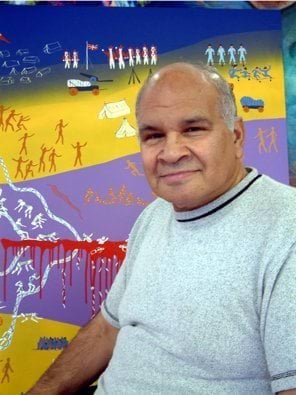
- Inducted:
- 2017
Bangerang man, artist and educator, Eddie ‘Kookaburra’ Kneebone, was born in Melbourne at the Royal Women’s Hospital in 1947. He was the eldest of fourteen children, having eight sisters and five brothers. As a young boy Eddie lived with his family at Orbost on the Snowy River where his parents worked as share farmers on a dairy property.
Within the Bangerang nation, Eddie’s extended family group was the Thooloolagong of the Ulupna Island area, in what is now the Barmah National Park. The Thooloolagong were known as the Kookaburra people and it was for this reason that Eddie’s totem was the kookaburra and he often signed his name Eddie ‘Kookaburra’ Kneebone.
Eddie’s family travelled around a lot when he was young. When they came to Melbourne in 1952, Eddie began school at the Fitzroy State School, then attended Bellfield School at Heidelberg, before the family moved to Kinglake. Times were tough for the family and Eddie left school at age 13 with limited reading and writing skills. The family relied on Eddie to help support his brothers and sisters and he recalled that the day after he left school he was ‘out in the field working, cutting down trees’.
Learning about Aboriginal heritage
When very young Eddie learnt about his Aboriginal heritage from his grandmother. He recalled that: ‘she taught us about Aboriginal life, telling the stories and all sorts of things that had happened in history’, but he did not value these stories until he was much older.
After leaving Kinglake, Eddie became itinerant working mostly in New South Wales. Eddie worked in many different occupations as a young man, mostly in rural locations, before finding satisfying work as a park ranger in Victoria. A turning point in his life was his marriage to Valerie Gormly in 1972. Eddie and Val had three children – Scott, Belinda and Leanda. It was while Eddie was working as a park ranger, aged 39, that the opportunity came through his employer to undertake further studies and gain some qualifications. He recalled: ‘twenty six years out of school and I went back to school. It wasn't as hard as I thought.’
Educating children in Aboriginal culture
Eddie soon developed an awareness of the need for young people to be educated in Aboriginal culture. He noticed this first with his own children who came home from school with what he believed to be an ‘incorrect version of Aboriginal history’, so he decided to do something about it. In the 1990s he developed and produced cultural awareness programs for both the private and public sectors through teaching and artwork.
Eddie taught himself to paint by observing others. He mastered many different styles of art including the traditional dot style, a contemporary brush style, pen and ink figures, and a whimsical pencil and pen style. His works of art now hang in public and private institutions all over the world, including in Parliament House and Government House in Melbourne, as well as in Tokyo, Canada, England and Ireland.
From 1999, Eddie was Wodonga TAFE’s artist-in-residence, a role which incorporated lecturing in the Aboriginal visual arts program. This work had a far reaching impact on students, especially Aboriginal pupils. Students were influenced by Eddie, not only to develop as artists, but also to acknowledge and celebrate their Aboriginality. In 1999 he was chosen as Wodonga’s Citizen of the Year.
Pax Christi International Peace Prize
In 2001, Eddie Kneebone received the Pax Christi International Peace Prize for his work. This award from the Catholic peace movement honoured Eddie for his efforts in bringing young Australians together. It was the first time the prize had been awarded to anyone in the southern hemisphere. Eddie was recognised for his efforts towards reconciliation as a day to day process, looking at Aboriginal culture, explaining it and getting people together to understand it. In explaining his work during an ABC interview,
Eddie articulated:
“It's about understanding who you are as a human and where you fit within the picture of the world of humans. The colour of your skin is important in your identity but it is not important in your understanding of who you are. We're all humans.”
Drawing on his heritage and work as a park ranger, Eddie wrote expertly on interpreting traditional culture in land management for the Victorian Department of Conservation and Environment. His knowledge and research brought insights into the relationship between the movement of Aboriginal people and the seasons in the north-east region of Victoria.
Art and education
Continuing Eddie’s work in art and education, the Eddie 'Kookaburra' Kneebone Gallery was officially opened in Wodonga in 2009. In naming the gallery, art students chose to celebrate and recognise the great energy Eddie 'Kookaburra' Kneebone put into encouraging Indigenous and non-Indigenous people of all ages to develop their artistic talents. The gallery extends the business capability of Aboriginal and Torres Strait Islander art students through formal training so the students can proactively market their artwork, and earn a sustainable living from their skills. The Wodonga TAFE's Koori art program has now become an integral part of the fabric of Albury Wodonga's Indigenous community.
Eddie Kneebone died in 2005 of diabetes complications. He was just 58 years old but his mantra lives on: ‘You can do whatever you want, have a dream, believe in it.’
Updated

